Hiking is a fantastic way to stay fit and healthy whilst spending plenty of time outdoors in the fresh air.
Regular hikes can improve your fitness, strengthen your muscles and are beneficial to your mental health. But what do you do when your healthy hobby starts causing you knee pain?
In this article we will walk you through some of the most common causes of knee pain, how to treat them, and how to prevent them from happening again.
Anatomy of the Knee
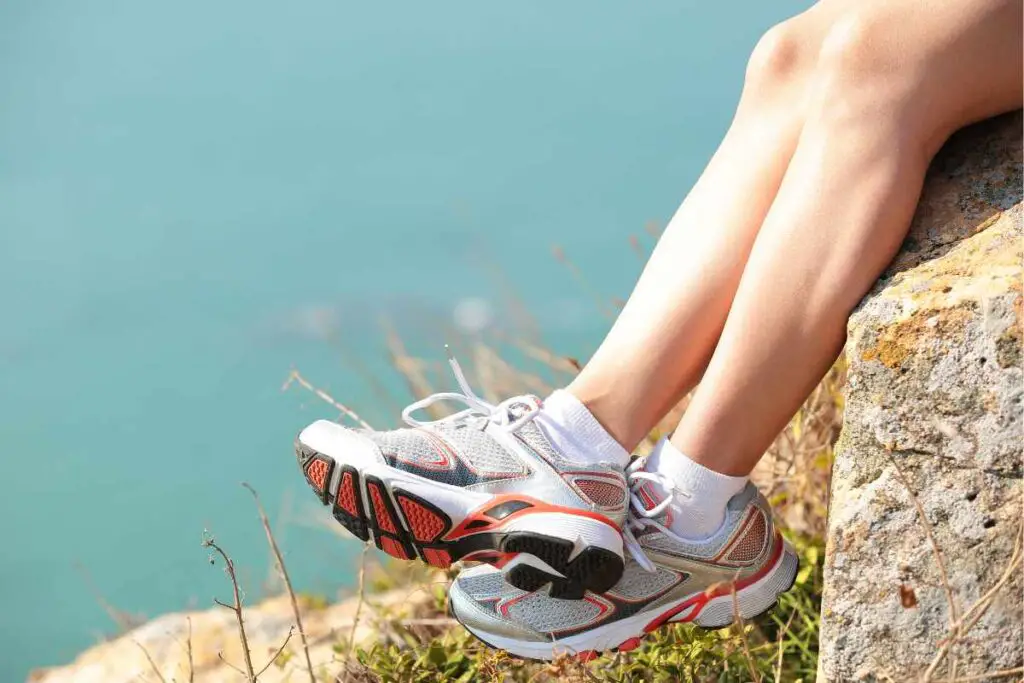
The knee is a complex joint consisting of several components that work together to allow for flexibility and stability.
These components include bones, cartilage, ligaments, and tendons:
- Bones: The knee joint is formed where the femur (thigh bone), tibia (shin bone), and patella (kneecap) meet.
- Cartilage: Two types of cartilage provide cushioning and smooth movement in the knee joint. Articular cartilage covers the ends of bones, while the meniscus is a C-shaped piece of cartilage that absorbs shock and stabilizes the joint.
- Ligaments: Four primary ligaments in the knee connect the bones and provide stability. The anterior cruciate ligament (ACL) and posterior cruciate ligament (PCL) are responsible for forward and backward movement, while the medial collateral ligament (MCL) and lateral collateral ligament (LCL) control sideways movement.
- Tendons: These connect the muscles around the knee to the bones, allowing for movement and support.
Injury or strain to any of these components can result in knee pain during or after hiking.
Tendinitis, for example, occurs when repetitive stress causes small tears in the tendon. Proper form, regular stretching, and adequate hydration can help prevent knee pain on the trail.
What Causes Knee Pain from Hiking?
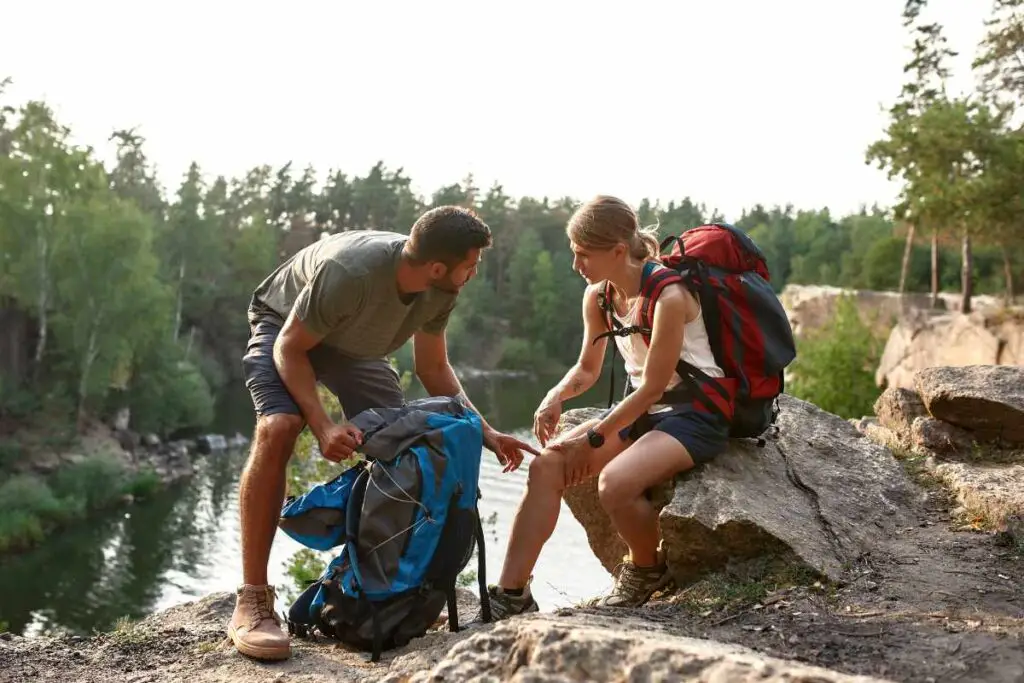
The structure of the knee, a weight-bearing hinge joint, is not ideally designed for the pressures involved in hiking. According to Harvard Medical School, inclines can impose two to three times a person’s body weight on their knees, while declines can add even more pressure. Additionally, overuse and inadequate recovery time could contribute to knee pain in hikers.
There are several causes of knee pain related to hiking as well as various preventative measures and treatments available. Understanding the potential causes, signs, and effective strategies can help hikers minimize their risk of knee discomfort and continue enjoying their time on the trails.
Knee pain during or after hiking can be caused by many things, often depending on your experience level and how challenging the trail is. But there are some issues that affect a lot of hikers.
Several factors contribute to hiking knee pain, including:
- Uneven terrain: Hiking trails often have rocks, roots, and uneven surfaces that can strain the knee joint.
- Poor hiking form: Leaning too far forward or backward, overextending the knees, or taking long strides can lead to pain.
- Inadequate footwear: Worn or unsupportive footwear can result in uneven distribution of pressure on the knees.
- Muscle imbalances: Weak or inflexible leg muscles might lead to increased strain on the joints during hiking.
Excessive strenuous activity or overuse can put strain on the knee joint and surrounding muscles, causing pain and sometimes long-term injury.
If you are new to hiking, it’s better to gradually increase your mileage and allow your fitness to improve before attempting the longer and more challenging routes. Taking rest days in between hikes will also help to avoid pain from overuse.
People often assume the ascent is the hardest part of the hike. It’s true that an uphill climb requires a lot of strength and stamina, but a steep descent actually puts more compressive force on the knee joint.
Side stepping on a decline can help to reduce the pressure on your knees and prevent injury.
When you walk on uneven ground, your muscles take on extra strain as they try to stabilise your body. This can cause pain around the knee joint.
Bumpy trails can also put you at risk of losing your balance and twisting your knee. Try using hiking poles for extra support to help avoid this.
If your leg muscles are weak or under-developed, your body may try to overcompensate by carrying more of your body weight through your knees. Consider some strength and conditioning exercises in between hikes to keep your muscles in good shape.
The more strenuous the trail, the more important it is to wear the right footwear. Good quality hiking boots provide vital support to your knee joint and help prevent injury. If you aren’t ready to invest in a pair of boots then consider buying insoles for extra cushioning.
When to Seek Medical Help

Symptoms Requiring Attention
Knee pain is a common issue many hikers face. However, it is important to recognize when it is time to consult a medical professional. Seek medical help if you experience any of the following:
- Swelling that worsens after 48 hours
- Clicking sounds as tendons snap over one another due to swelling
- Severe pain that limits your mobility
- Pain, instability or stiffness lasting for more than a week
- Signs of infection, such as warmth, redness, or fever
Treatment Options
When knee pain interferes with your hiking experience, several treatments are available.
Your healthcare provider may recommend one or more of these options:
- Rest: Taking a break from hiking and other activities that cause stress on your knees can help support recovery.
- Ice: Applying ice to the knee for 15-20 minutes a few times a day can help reduce inflammation and alleviate pain.
- Compression: Wrapping an elastic bandage around your knee helps control swelling but should not be too tight to cause pain or leg swelling.
- Elevation: Keeping your knee elevated above your heart level can help reduce swelling and promote circulation.
- Knee support: Using a knee brace or compression sleeve can provide extra stability and pain relief.
- Physiotherapy: A physiotherapist can offer a personalized exercise program to strengthen the muscles that support your knees.
- Medication: Over-the-counter pain relievers or anti-inflammatory medications may be recommended to alleviate discomfort.
- Surgery: In severe cases or when other treatments have not been effective, surgery may be necessary to address the underlying cause of knee pain.
What to do about Knee Pain from Hiking?
How you treat your knee pain depends on what kind of injury you have.
A sharp shooting pain can be indicative of tendinitis. This is when repetitive stress on the knee causes small tears in the tendon. Apply ice to the injury as soon as possible, then alternate between ice and heat.

Anti-inflammatories can help to speed the recovery and reduce pain. It is important to rest your knee for at least a few days or until the symptoms have eased, and to elevate your leg if possible.
You can do this by placing pillows on a chair until you reach the desired height so that your knee and ankle are above your hips when your leg is outstretched.
A persistent ache in the knee can be a sign of worn down cartilage. Take a few days rest and make sure you are wearing good quality hiking boots that offer plenty of support for your joints.
If you have pain and swelling in the inner side of the knee below the joint, you could have Bursitis. This occurs when overuse of the knee causes the fluid sacs that protect the joint to become inflamed.
Your skin may be tender and warm to the touch. Avoid bearing weight on your knee until the symptoms have improved, and use ice and anti-inflammatories to reduce the swelling and ease the pain.
Many hiker’s suffer with generic knee pain often referred to as ‘hiker’s knee’. Most often, this is caused by the knee taking too much pressure during steep descents, or walking long distances on uneven ground.
Over the counter medication and plenty of rest will usually fix this issue, and ice can be applied if necessary.
If you are experiencing any of these symptoms and notice no improvements after several days, you may need to seek medical advice.
Preventing Knee Pain on the Trail
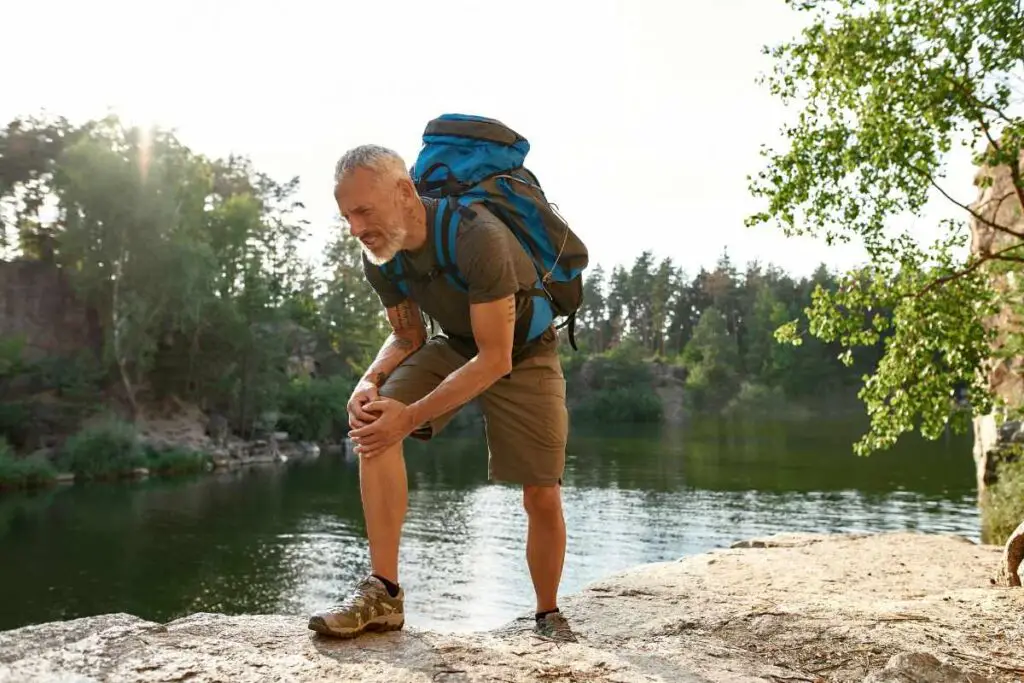
Proper Hiking Footwear
Wearing the right footwear can significantly reduce the risk of knee pain when hiking. Be sure to choose shoes with good arch support, cushioning, and a sturdy, durable construction.
A proper fit is also essential, as ill-fitting shoes can cause discomfort and contribute to knee pain.
Additionally, invest in high-quality hiking socks that provide support and moisture-wicking to keep your feet dry and comfortable.
Warm Up and Stretching
Before hitting the trail, it’s essential to warm up and stretch your muscles.
Focus on leg stretches, such as calf raises, hamstring stretches, and quadriceps stretches. Warming up your body and improving flexibility can help reduce the risk of injury and knee pain while hiking.
Use of Trekking Poles
Trekking poles can be beneficial in reducing the pressure on your knees when hiking, particularly when going downhill.
They provide added stability and help disperse some of the impact to your upper body. Ensure that the poles are the appropriate length for your height, and learn how to use them effectively for maximum benefit.
Managing Hiking Stride
Maintaining proper hiking form can help prevent knee pain. Techniques to reduce strain on joints include:
- Avoid locking your knees when hiking downhill. Keep them slightly flexed, and go slow.
- Create mini-switchbacks when hiking downhill by traveling in a zig-zag pattern, which is easier on the knees than heading straight downhill.
- Practicing side stepping on declines can reduce pressure on your knees and prevent injury.
Effective management of your hiking stride, coupled with proper footwear, warm-ups, and the use of trekking poles, can ensure a more comfortable and enjoyable hiking experience while minimizing the risk of knee pain.
Immediate Relief during Hikes

Rest and Elevation
When experiencing knee pain during a hike, it is essential to take a break and rest your knee. Find a comfortable spot to sit down and elevate your leg if possible.
This will help reduce any swelling and promote blood flow for a quicker recovery. Remember, it’s better to rest for a short period of time rather than push through the pain and risk further injury.
Icing the Knee
Applying ice to the affected knee can provide immediate relief from pain and inflammation.
If you don’t have an ice pack handy, consider using a cold water bottle or a wet cloth to cool the area.
Apply the ice for 10-15 minutes, removing it for a few minutes, and then reapplying as needed. Be sure to avoid direct contact with the skin to prevent frostbite.
Compression and Support
Providing compression and support to your knee can also alleviate discomfort during a hike.
Wearing a knee brace or compression wrap may help stabilize the knee joint, enhance circulation, and minimize swelling.
Keep in mind that it is crucial to avoid over-tightening the brace or wrap, as this may restrict blood flow and cause further issues.
Long Term Methods for Reducing Knee Pain
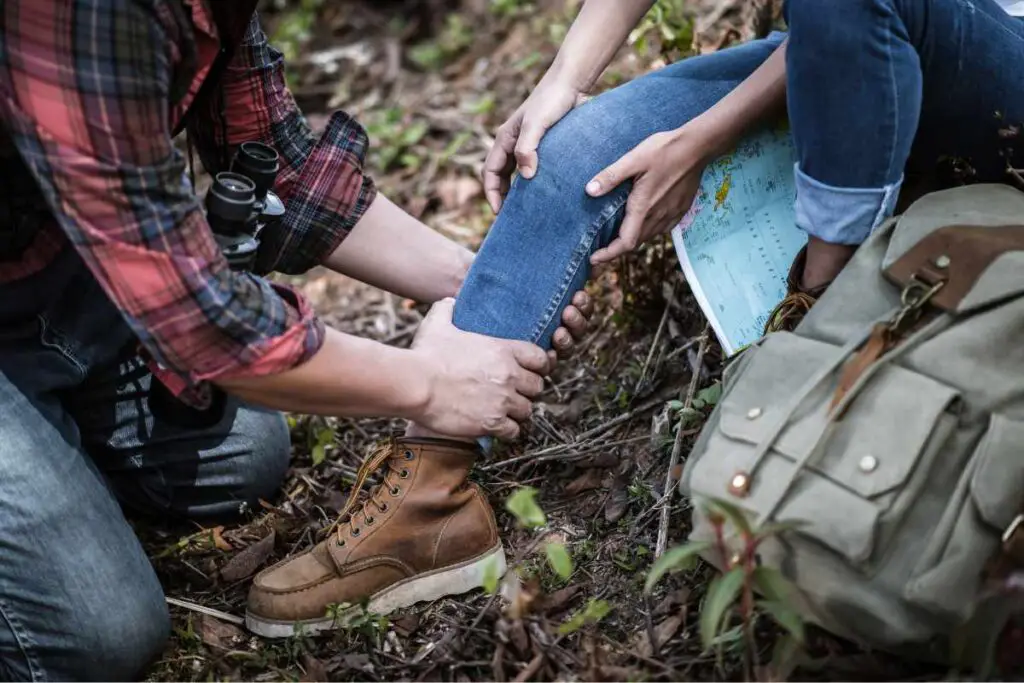
Strength Training
One effective way to reduce knee pain during hiking is to incorporate strength training into your exercise routine.
Strengthening the muscles around the knee, such as quadriceps, hamstrings, and calf muscles, can help provide more support to the joint and reduce excessive stress on it.
Some possible exercises include:
- Leg Presses: Adjust the weight to your comfort level and use proper form to avoid excessive strain on your knees.
- Lunges: Bodyweight lunges can help strengthen your quadriceps and hamstrings. Make sure to keep your knee aligned with your ankle during the exercise.
- Calf Raises: Work on your calf muscles by performing calf raises, either with bodyweight or using resistance like dumbbells or a calf raise machine.
Read next – How to Train for Hiking Without Hiking
Building Flexibility and Mobility
Improving flexibility and mobility in the muscles and joints around the knee can also help reduce knee pain during hiking.
Stretching and mobility exercises can improve your range of motion and reduce stiffness.
Some beneficial stretches and exercises include:
- Hamstring Stretches: Sit on the ground and straighten one leg while bending the other, then gently reach for the toes of the straightened leg. Hold the stretch for 30 seconds and switch legs.
- Quadriceps Stretches: Stand on one leg and grasp your opposite ankle behind you, gently pulling your foot towards your glute. Hold the stretch for 30 seconds and switch legs.
- Calf Stretches: Place one foot behind the other with your heel on the ground, leaning forward to stretch the calf muscle. Hold for 30 seconds and switch legs.
Maintenance of Healthy Weight
Maintaining a healthy weight is crucial in reducing knee pain, especially when hiking.
Excess weight puts additional stress on the knee joint, which can lead to more inflammation, pain, and long-term damage.
By keeping your weight within a healthy range, you can help minimize the impact on your knees and potentially reduce discomfort while hiking.
To achieve a healthy weight, consider a balanced diet and regular exercise routine.
The key is to focus on:
- A well-balanced diet: Incorporating a variety of fruits, vegetables, lean proteins, and whole grains into your meals can provide essential nutrients and help you maintain a healthy weight.
- Regular physical activity: Engaging in a mix of cardiovascular exercises and strength training can support weight management and contribute to overall joint health.
Read next – Is hiking good cardio?
In conclusion, maintaining a healthy weight is an effective long-term method for reducing knee pain.
By adopting a balanced diet and exercising regularly, you can minimize the stress on your knee joints and alleviate discomfort while hiking.
Frequently Asked Questions

How can I alleviate knee pain during hiking?
To alleviate knee pain during hiking, ensure you’re wearing proper footwear with good arch support and cushioning.
Use trekking poles to help distribute your weight and reduce stress on your knees. Take breaks when needed and avoid carrying excessive weight. Stick to smoother trails when possible and perform stretches before and after your hike.
What are common symptoms of hikers knee?
Common symptoms of hikers knee include pain around or behind the kneecap, swelling or inflammation, and a clicking or grinding sensation during movement. Pain may increase when walking downhill, climbing stairs, or during prolonged sitting.
What are some exercises to prevent knee pain while hiking?
To prevent knee pain while hiking, perform exercises that strengthen the muscles around your knees, such as:
1. Quadriceps strengthening: Leg extensions, step-ups, and lunges can help build up the muscles supporting your knees.
2. Hamstring and calf strengthening: Hamstring curls and calf raises can improve the balance and strength of the muscles around your knees.
3. Core exercises: Planks, bridges, and side planks can help improve your balance and stability, reducing stress on your knees during hiking.
Should I use a knee brace for hiking?
Using a knee brace for hiking can provide additional support and stability, especially if you have an existing knee condition or are prone to knee injuries.
Consult with a healthcare professional for recommendations on specific knee braces suitable for your needs.
How long does it take to recover from hikers knee?
Recovery from hikers knee varies based on the severity of the condition and individual factors.
Mild cases may resolve within a few days, while more severe cases may take weeks or months. Rest, ice, compression, and elevation (RICE) can help speed up recovery. Consult with a healthcare professional for personalized advice on recovery time and management.
What is the best way to tape knees for downhill hiking?
Taping your knees for downhill hiking can provide additional support and stability.
To tape your knees effectively, use kinesiology tape and follow these steps:
1. Begin with a clean and dry knee.
2. Measure and cut strips of tape long enough to wrap around your knee.
3. Apply the first strip directly below the kneecap in a rounded horseshoe shape.
4. Apply the second strip, starting on the outside of your knee and wrapping over the kneecap towards the inside. Repeat in the opposite direction.
5. Rub the tape gently to activate the adhesive and ensure it adheres properly.
Always consult a healthcare professional or a certified athletic trainer for expert guidance on taping techniques before attempting this on your own.
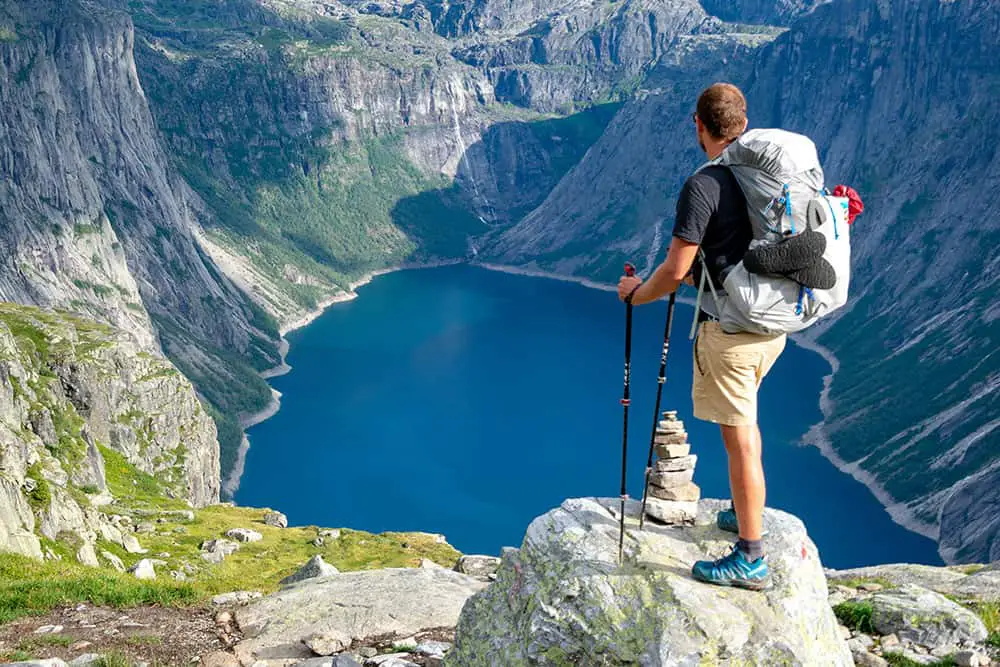

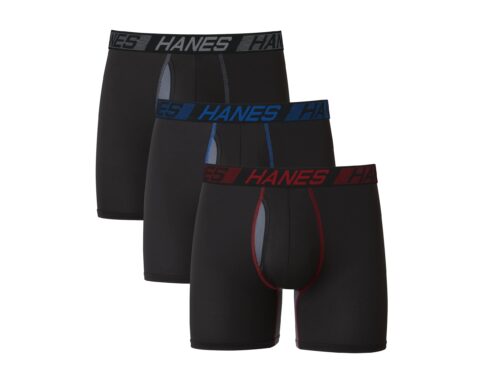



[…] prevent wide feet from feeling cramped and uncomfortable in narrow shoes, which can lead to a very painful hiking […]